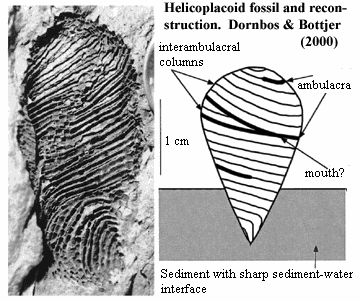Helicoplacoidea
Armour-Plated Spirals
Helicoplacoidea are known only from the Early Cambrian of western North America, no later the Atdabanian. Articulated body fossils are rare, and they are mostly known as dissociated plates. Durham 1993). Helicoplacoidea had a football-shaped body (rugby or American football, not soccer) with ambulacra running spirally down it. At the anterior end there are two ambulacra that meet partway down the body leading to a single ambulacrum posteriorly. The apparent connection of plates by soft tissue rather than direct articulations suggests that the body could be expanded or contracted as required.
 Most authors interpret the life position of helicoplacoids as sessile, standing upright with the double-ambulacral end upwards. Some authors have argued that the flexibility of the test indicates a more vagile lifestyle in a reclined position, either on the substrate surface or burrowing. However, such a position appears inconsistent with the spiral ambulacra which obviously function to maximise exposure on all sides. The single ambulacrum does not reach the point of the downwards end, which was probably partially buried in the sediment to anchor the animal.
Most authors interpret the life position of helicoplacoids as sessile, standing upright with the double-ambulacral end upwards. Some authors have argued that the flexibility of the test indicates a more vagile lifestyle in a reclined position, either on the substrate surface or burrowing. However, such a position appears inconsistent with the spiral ambulacra which obviously function to maximise exposure on all sides. The single ambulacrum does not reach the point of the downwards end, which was probably partially buried in the sediment to anchor the animal.
The position of the mouth is a matter of some debate. One interpretation places the mouth at the junction of the ambulacra, implying a triradial organisation as has been suggested to be the direct forerunner of the 2-1-2 organisation of the most basal pentameral stem echinoderms. See, e.g., Dominguez-Alonso 1999). Durham (1993) found no sign of a structure identifiable as a mouth at this position in articulated specimens and supported an alternative position at the uppermost point, though it should be noted that no likely structure was identified there either. Even in articulated specimens, however, the loose organisation of helicoplacoids generally results in some shifting of individual plates, making interpretation more difficult. A dorsal position for the mouth does seem more likely for the sole reaspon that this is the position in almost every other sessile radial animal. The animal is then generally regarded as uniradial with the left adoral ambulacrum regarded as a branch of the main ambulacrum. One possibility which doesn't appear to have been considered is that helicoplacoids were derived from bilateral ancestors, with the left ambulacrum representing the DE branch and the right the BC. The posterior fusion of the ambulacra would then probably be unique, but surely no less likely than the secondary branching and change of direction otherwise required.
In light of this possibility, we put Helicoplacoidea crownwards of the Ctenocystoidea based on a single character, the dorsal rather than anterior position of the mouth (alternatively, a triradial reconstruction would definitely put the helicoplacoids crownwards).
© Christopher Taylor CT050915.
page uploaded ATW050915
 Most authors interpret the life position of helicoplacoids as sessile, standing upright with the double-ambulacral end upwards. Some authors have argued that the flexibility of the test indicates a more vagile lifestyle in a reclined position, either on the substrate surface or burrowing. However, such a position appears inconsistent with the spiral ambulacra which obviously function to maximise exposure on all sides. The single ambulacrum does not reach the point of the downwards end, which was probably partially buried in the sediment to anchor the animal.
Most authors interpret the life position of helicoplacoids as sessile, standing upright with the double-ambulacral end upwards. Some authors have argued that the flexibility of the test indicates a more vagile lifestyle in a reclined position, either on the substrate surface or burrowing. However, such a position appears inconsistent with the spiral ambulacra which obviously function to maximise exposure on all sides. The single ambulacrum does not reach the point of the downwards end, which was probably partially buried in the sediment to anchor the animal.